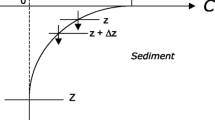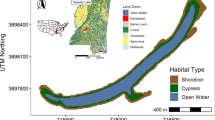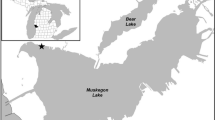Abstract
This study aims at investigating decomposition processes in wetlands that are daily or seasonally exposed to intermittent oxic and anoxic conditions. We hypothesized that in wetland ecosystems where anoxia regularly establishes, decomposition rates are not affected by oxygen shortage, especially when nitrates are available. Monitoring and experiments were performed from December 2003 to January 2005 in one of the widest (81 ha) freshwater wetlands in the Po river floodplain (Natural Reserve Paludi del Busatello, Italy). Intact sediment cores were sampled on a seasonal basis. Sediment–water fluxes of oxygen, dissolved inorganic carbon, methane, and inorganic nitrogen were determined under oxic and anoxic conditions. Oxic–anoxic transitions always resulted in enhanced ammonium, dissolved inorganic carbon, and methane effluxes. At high temperatures, the methane release from sediments was inversely related to both nitrate concentrations and uptake. Likely, nitrate can compensate for the oxygen deficiency while maintaining an oxidative metabolism, either supporting microbial decomposition as an electron acceptor or stimulating the oxidation of the byproducts of the anaerobic metabolism, e.g., methane. This is a key point as the number of temperate wetlands with concurrent nitrate pollution and oxygen shortage is increasing throughout the world.






Similar content being viewed by others
References
Anderson, L. G., P. O. J. Hall, A. Iverfeldt, M. M. R. Van Der Loeff, B. Sundby & S. F. G. Westerlund, 1986. Benthic respiration measured by total carbonate production. Limnology and Oceanography 31: 319–329.
APHA, 1998. Standard Methods for the Examination of Water and Wastewaters, 20th ed. APHA, Washington, DC.
Barica, J. & J. A. Mathias, 1979. Oxygen depletion and winterkill risk in small prairie lakes under extended ice cover. Journal of the Fisheries Research Board of Canada 36: 980–986.
Bartoli, M., E. Racchetti, C. A. Delconte, E. Sacchi, E. Soana, A. Laini, D. Longhi & P. Viaroli, 2012. Nitrogen balance and fate in a heavily impacted watershed (Oglio River, Northern Italy): in quest of the missing sources and sinks. Biogeosciences 9: 361–373.
Bastviken, D., L. Persson, G. Odham & L. Tranvik, 2004. Degradation of dissolved organic matter in oxic and anoxic lake water. Limnology and Oceanography 49: 109–116.
Bolpagni, R., E. Pierobon, D. Longhi, D. Nizzoli, M. Bartoli, M. Tomaselli & P. Viaroli, 2007. Diurnal exchanges of CO2 and CH4 across the water–atmosphere interface in a water chestnut meadow (Trapa natans L.). Aquatic Botany 87: 43–48.
Capone, D. G. & R. P. Kiene, 1988. Comparison of microbial dynamics in freshwater and marine environments: contrasts in anaerobic carbon catabolism. Limnology and Oceanography 33: 725–749.
Carignan, R. & D. R. S. Lean, 1991. Regeneration of dissolved substances in a seasonally anoxic lake: the relative importance of processes occurring in the water column and in the sediments. Limnology and Oceanography 36: 683–707.
Dalsgaard, T., L. P. Nielsen, V. Brotas, P. Viaroli, G. J. C. Underwood, D. B. Nedwell, K. Sundback, S. Rysgaard, A. Miles, M. Bartoli, L. Dong, D. C. O. Thornton, L. D. M. Ottosen, G. Castaldelli & N. Risgaard-Petersen, 2000. Protocol handbook for NICE-Nitrogen Cycling in Estuaries: a project under the EU research programme. Marine Science and Technology (MAST III).
Diaz, R. J. & R. Rosenberg, 2008. Spreading dead zones and consequences for marine ecosystems. Science 321: 926–929.
Fenner, N. & C. Freeman, 2011. Drought-induced carbon loss in peatlands. Nature Geoscience 4: 895–900.
Ford, P. W., P. I. Boon & K. Lee, 2002. Methane and oxygen dynamics in a shallow floodplain lake: the significance of periodic stratification. Hydrobiologia 485: 97–110.
Grybos, M., M. Davranche, G. Gruau, P. Petitjean & M. Pédrot, 2009. Increasing pH drives organic matter solubilization from wetland soils under reducing conditions. Geoderma 154: 13–19.
Guntiñas, M. E., F. Gil-Sotres, M. C. Leirós & C. Trasar-Cepeda, 2009. CO2 emission from soils under different uses and flooding conditions. Soil Biology and Biochemistry 41: 2598–2601.
Hanke, A., C. Cerli, J. Muhr, W. Borken & K. Kalbitz, 2013. Redox control on carbon mineralization and dissolved organic matter along a chronosequence of paddy soils. European Journal of Soil Science 64: 476–487.
Hulthe, G., S. Hulth & P. O. J. Hall, 1998. Effect of oxygen on degradation rate of refractory and labile organic matter in continental margin sediments. Geochimica et Cosmochimica Acta 62: 1319–1328.
Kane, E. S., M. R. Chivers, M. R. Turetsky, C. C. Treat, D. G. Petersen, M. Waldrop, J. W. Harden & A. D. McGuire, 2013. Response of anaerobic carbon cycling to water table manipulation in an Alaskan rich fen. Soil Biology and Biochemistry 58: 50–60.
Kemp, W. M., W. R. Boynton, J. E. Adolf, D. F. Boesch, W. C. Boicourt, G. Brush, J. C. Cornwell, T. R. Fisher, P. M. Glibert, J. D. Hagy, L. W. Harding, E. D. Houde, D. G. Kimmel, W. D. Miller, R. I. E. Newell, M. R. Roman, E. M. Smith & J. C. Stevenson, 2005. Eutrophication of Chesapeake Bay: historical trends and ecological interactions. Marine Ecology Progress Series 303: 1–29.
Koroleff, F., 1970. Direct determination of ammonia in natural waters as indophenol blue. Information on Techniques and Methods for Seawater Analysis. ICES Journal of Marine Science 114: 799–801.
Kristensen, E., 2000. Organic matter diagenesis at the oxic/anoxic interface in coastal marine sediments, with emphasis on the role of burrowing animals. Hydrobiologia 426: 1–24.
Kristensen, E. & T. H. Blackburn, 1987. The fate of organic carbon and nitrogen in experimental marine sediment systems: influence of bioturbation and anoxia. Journal of Marine Research 45: 231–257.
Kristensen, E., S. I. Ahmed & A. H. Devol, 1995. Aerobic and anaerobic decomposition of organic matter in marine sediment: which is fastest? Limnology and Oceanography 40: 1430–1437.
Lenth R., 2015. lsmeans: least-squares means. R package version 2.20-23.
Liikanen, A., T. Murtoniemi, H. Tanskanen, T. Vaisanen & P. J. Martinkainen, 2002. Effects of temperature and oxygen availability on greenhouse gas and nutrient dynamics in sediment of a eutrophic mid-boreal lake. Biogeochemistry 59: 269–286.
Liu, R., A. Hofmann, F. O. Gülaçar, P.-Y. Favarger & J. Dominik, 1996. Methane concentration profiles in a lake with a permanently anoxic hypolimnion (Lake Lugano, Switzerland-Italy). Chemical Geology 133: 201–209.
Longhi, D., M. Bartoli & P. Viaroli, 2008. Decomposition of four macrophytes in wetland sediments: organic matter and nutrient decay and associated benthic processes. Aquatic Botany 89: 303–310.
Longhi, D., M. Bartoli, D. Nizzoli & P. Viaroli, 2013. Benthic processes in fresh water fluffy sediments undergoing resuspension. Journal of Limnology 72: 1–12.
Lovley, D. R. & M. J. Klug, 1982. Intermediary Metabolism of Organic Matter in the Sediments of a Eutrophic Lake. Applied and Environmental Microbiology 43: 552–560.
Maerki, M., B. Mueller, C. Dinkel & B. Wehrli, 2009. Mineralization pathways in lake sediments with different oxygen and organic carbon supply. Limnology and Oceanography 54: 428–438.
Middelburg, J. J. & L. A. Levin, 2009. Coastal hypoxia and sediment biogeochemistry. Biogeosciences 6: 1273–1293.
Nielsen, L. P., 1992. Denitrification in sediment determined from nitrogen isotope pairing. Fems Microbiology Ecology 86: 357–362.
Nizzoli, D., E. Carraro, V. Nigro & P. Viaroli, 2010. Effect of organic enrichment and thermal regime on denitrification and dissimilatory nitrate reduction to ammonium (DNRA) in hypolimnetic sediments of two lowland lakes. Water Research 44: 2715–2724.
Pinheiro, J., D. Bates, S. DebRoy, D. Sarkar & R Core Team, 2014. nlme: linear and nonlinear mixed effects models. R package version 3.1-118.
Quiñones-Rivera, Z. J., B. Wissel, N. N. Rabalais & D. Justic, 2010. Effects of biological and physical factors on seasonal oxygen dynamics in a stratified, eutrophic coastal ecosystem. Limnology and Oceanography 55: 289–304.
R Core Team, 2014. R: A language and environment for statistical computing. R Foundation for Statistical Computing, Vienna.
Racchetti, E., M. Bartoli, E. Soana, D. Longhi, R. R. Christian, M. Pinardi & P. Viaroli, 2011. Influence of hydrological connectivity of riverine wetlands on nitrogen removal via denitrification. Biogeochemistry 103: 335–354.
Revsbech, N. P., J. Sorensen, T. H. Blackburn & J. P. Lomholt, 1980. Distribution of oxygen in marine sediments measured with microelectrodes. Limnology and Oceanography 25: 403–411.
Ribaudo, C., M. Bartoli, E. Racchetti, D. Longhi & P. Viaroli, 2011. Seasonal fluxes of O2, DIC and CH4 in sediments with Vallisneria spiralis: indications for radial oxygen loss. Aquatic Botany 94: 134–142.
Rose, C. & W. G. Crumpton, 1996. Effects of emergent macrophytes on dissolved oxygen dynamics in a prairie pothole wetland. Wetlands 16: 495–502.
Smemo, K. A. & J. B. Yavitt, 2011. Anaerobic oxidation of methane: an underappreciated aspect of methane cycling in peatland ecosystems? Biogeosciences 8: 779–793.
Smith, V. H., G. D. Tilman & J. C. Nekola, 1999. Eutrophication: impacts of excess nutrient inputs on freshwater, marine, and terrestrial ecosystems. Environmental Pollution 100: 179–196.
Sørensen, J., B. B. Jørgensen & N. P. Revsbech, 1979. A comparison of oxygen, nitrate, and sulfate respiration in coastal marine sediments. Microbial Ecology 5: 105–115.
Stadmark, J. & L. Leonardson, 2007. Greenhouse gas production in a pond sediment: effects of temperature, nitrate, acetate and season. Science of the Total Environment 387: 194–205.
Sun, M.-Y., S. G. Wakeham & C. Lee, 1997. Rates and mechanisms of fatty acid degradation in oxic and anoxic coastal marine sediments of Long Island Sound, New York, USA. Geochimica et Cosmochimica Acta 61: 341–355.
Sweerts, J.-P. R. A., M.-J. Bar-Gilissen, A. A. Cornelese & T. E. Cappenberg, 1991. Oxygen-consuming processes at the profundal and littoral sediment-water interface of a small meso-eutrophic lake (Lake Vechten, The Netherlands). Limnology and Oceanography 36: 1124–1133.
Viaroli, P. & R. R. Christian, 2003. Description of trophic status of an eutrophic coastal lagoon through potential oxygen production and consumption: defining hyperautotrophy and dystrophy. Ecological Indicators 3: 237–250.
Author information
Authors and Affiliations
Corresponding author
Additional information
Guest editors: Pierluigi Viaroli, Marco Bartoli & Jan Vymazal / Wetlands Biodiversity and Processes: Tools for Management and Conservation
Rights and permissions
About this article
Cite this article
Longhi, D., Bartoli, M., Nizzoli, D. et al. Do oxic–anoxic transitions constrain organic matter mineralization in eutrophic freshwater wetlands?. Hydrobiologia 774, 81–92 (2016). https://doi.org/10.1007/s10750-016-2722-x
Received:
Revised:
Accepted:
Published:
Issue Date:
DOI: https://doi.org/10.1007/s10750-016-2722-x




